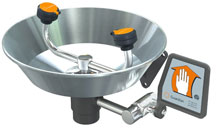| The Home page of ILPI's Safety Data Sheet (SDS) Resource, the leader in SDS information since 1995! | |
| The history and philosophy behind this resource. | |
| A curated collection of books and reference materials concerning Safety Data Sheets and closely related topics. | |
| Paste your plain text SDS into the SDS-Demystifier, and it will be converted into a hypertext-enriched document with links to detailed explanations of each key term. | |
| An extensive list of frequently asked questions about Safety Data Sheets including regulations, content, compliance, and more. | |
| A humorous take on Safety Data Sheet jargon. Fill in the blanks on our entry form to generate a personalized Unsafety Data Sheet to share with your coworkers. | |
| Since 1995, we've maintained this massive curated list of the best places to find Safety Data Sheets on the Internet. | |
| You are here! Way more than a glossary, this hypertext-enhanced resource covers hundreds of SDS-related terms and expert knowledge. Each entry includes both the SDS relevance and links to additional authoritative resources. | |
| Archived results of Safety Data Sheet related polls taken by some of our millions of site visitors | |
| The OSHA regulations behind SDS regulations, including the inspection guidelines and over 400 official interpretations letters under the Hazard Communication Standard | |
| Commercial suppliers of SDS authoring and management software as well as cloud compliance services. | |
| Commercial companies that will create SDS's for your specific needs as well as SDS translation companies. |

Safety signs, banners, and scoreboards? Get yours at Safety Emporium!
Definition
A cataract is a partial or complete opacity (cloudiness) of one or both eyes. This usually occurs in the lens or capsule and can impair (interfere with) vision to the point of blindness.
Additional Info

Ensure workers understand what eye protection is really all about with safety posters from Safety Emporium.
The incidence of cataracts increases with age. The cause of cataracts is not often known, however certain diseases such as diabetes are associated with cataracts. Overexposure to the sun (UV radiation), smoking, hot work environments (such as furnaces or glassblowing), pesticide exposure, certain chemicals, as well as ionizing radiation can also increase the risk.
Cataracts can be treated with corrective lenses, medication and/or surgery. Replacement of the lens with an artificial lens is successful in approximately 98% of cases.
Books Available
NOTE: We may collect a share of sales or other compensation from the links in the following list:
- "The Cataract Surgery Book: Options & Explanations for Patients", Paperback, 91 pages, 2018. Estimated price $13.99. Info and/or order .
- "Cataract Surgery And Phacoemulsification For The Beginning Surgeons", Paperback, 312 pages, 2014. Estimated price $22.85. Info and/or order.
- "Cataract Surgery: A Patient's Guide to Cataract Treatment, 3rd Ed", Paperback, 160 pages, 2016. Estimated price $22.95. Info and/or order.
SDS Relevance
Prolonged (chronic) exposure to certain chemicals can cause cataract formation in the eyes, or a condition closely resembling cataracts. Examples of such chemicals include naphthlene, bendiocarb (a pesticide), potassium isocyanate, ethylene oxide, dinitrophenols, ammonium hydroxide, and osmium tetraoxide among others. The damage that these substances cause to your eyes may or may not be reversible.
Section 11 (toxicological information) of the Safety Data Sheet will explain such hazards. If you must use substances that can produce eye damage or cataracts, be sure to use proper administrative and engineering controls to prevent the release of the substances into your work environment.
Good ventilation is very important. Personal protective equipment (PPE) such as safety glasses and goggles offer no significant protection from fumes or vapors, so do not rely on these to protect your eyes! Air-supplying or PAPR respirators with full face masks are a good alternative, but simple dust masks or HEPA filters are ineffective against chemical fumes and vapors.
Further Reading

Safety Emporium carries all kinds of eye/face washes, safety showers, drench hoses and more.
- Visit the Cataracts FAQ at Johns Hopkins Medicine.
- Cataract: What You Should Know at the National Eye Institute (part of the U.S. National Institutes of Health).
- Cataracts Causes, Symptoms, Types, Treatment and Surgery Risks at eMedicineHealth.com.
- Cataract at the NIH's MedLine Plus Medical Encyclopedia.
- What Are Cataracts? at veryWellHealth
- Simulation of Cataracts at Cataract Eye Surgery (requires Flash).
- Ocular studies, including sleep, glaucoma and cataracts at BioMedSearch, a search engine for highly technical info on the topic.
- Cataract Educational Videos at Barnet Dulaney Perkins Eye Center.
See also: conjunctivitis, eye wash, sclera.